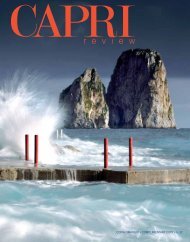COPIA OMAGGIO ⢠COMPLIMENTARY COPY EDIZIONI PRC
COPIA OMAGGIO ⢠COMPLIMENTARY COPY EDIZIONI PRC
COPIA OMAGGIO ⢠COMPLIMENTARY COPY EDIZIONI PRC
Create successful ePaper yourself
Turn your PDF publications into a flip-book with our unique Google optimized e-Paper software.
si preannunciano, s’abbattè sulla zona sorprendendo<br />
e travolgendo tutti i gozzi che<br />
sostavano intorno alla famosa secca.<br />
Nessuno degli occupanti delle decine e<br />
decine di barche scampò alla morte. Non<br />
era la prima volta che il mare mieteva il<br />
lutto in qualche famiglia di pescatori, ma<br />
questa volta le onde, di un’altezza e di una<br />
furia paurose, avevano provocato una strage.<br />
Le vedove di quei poveri pescatori non<br />
smisero mai più di indossare l’abito nero<br />
ed il luogo di quella immane sciagura è<br />
ancora oggi ricordato come la “Secca delle<br />
Vedove”. Il pittore John Benner si ispirò a<br />
questo triste episodio quando riprodusse in<br />
un bel dipinto ad olio, le donne disperate e<br />
piangenti su uno scoglio.<br />
I corallini di Torre<br />
Nel XVI secolo si verificò un certo esaurimento<br />
dei banchi di corallo intorno all’isola,<br />
allora i pescatori capresi si imbarcarono<br />
a servizio degli armatori di Torre del Greco,<br />
facendo vela versa la Sicilia e la Tunisia.<br />
Da aprile ad ottobre la loro vita diventava<br />
un lungo ed ingrato La statua della Madonna<br />
nella Chiesa di S. Maria<br />
lavoro. Passavano le di Costantinopoli a Torre<br />
del Greco. Nella mano<br />
giornate stipati in sinistra porta un ramo<br />
di corallo rosso.<br />
una barca senza ponte<br />
con solo biscotti The statue of the<br />
Madonna in the Church<br />
da mangiare e acqua of Santa Maria di<br />
Costantinopoli in Torre<br />
da bere spesso fetida, del Greco. She holds a<br />
branch of red coral in<br />
toccando terra raramente,<br />
senza dormire<br />
her left hand.<br />
per giorni di seguito e con un compenso<br />
estremamente inadeguato alla fatica e alla<br />
sofferenza che sopportavano. Ciò non<br />
scoraggiava i migliori ad intra-<br />
Sono firmati “Puttini” la collana in<br />
madreperla e corallo e i preziosi<br />
gemelli dove il corallo si sposa<br />
all’oro e ai diamanti neri.<br />
Puttini designed the necklace in<br />
coral and mother of pearl, as<br />
well as the precious cuff links<br />
which combine coral, gold,<br />
and black diamonds.<br />
<br />
CORAL DAY<br />
by Salvatore Borà<br />
Ancient history becomes a crafts<br />
tradition on Capri.<br />
Coral-fishing was practised around Capri<br />
in ancient times, though it only became<br />
an organized practice around 1800,<br />
according to the archives. Coral deposits once<br />
abounded around the island. The largest was<br />
at the “Bocche”, in the stretch of sea between<br />
Punta di Tiberio and Punta di Campanella;<br />
at Vitareta, around 200 m from the coast;<br />
at Gradola, near the Blue Grotto; between<br />
Matermania and Punta del Secco; 400 m<br />
from the Faraglioni; at Punta Carena near the<br />
lighthouse; and at various depths around the<br />
Grotte.<br />
The coral-fishing haul was so abundant in<br />
1277 that the ruling Angevins decided to<br />
establish a uniform excise duty to benefit<br />
the Crown on all coral fished; previously, the<br />
local customs had set this duty at their own<br />
discretion. Queen Joanna I of Anjou was<br />
always extremely keen on coral. She wore<br />
coral jewellery throughout her life, and as a<br />
little girl, had her clothing adorned with this<br />
precious gem. Following the construction<br />
of the San Giacomo Charterhouse,<br />
commissioned by Giacomo Arcucci in 1371,<br />
Queen Joanna II of Anjou awarded the<br />
monastery a number of sources of income. In<br />
addition to a levy of a tithe on fish taken from<br />
the waters belonging to the Charterhouse,<br />
she also awarded a tithe on coral. This gave<br />
rise to a succession of quarrels and disputes<br />
between the clergy, the bishopric and the<br />
university - in some years, the coral haul was<br />
worth thousands of ducats in levies to the<br />
monks.<br />
The “coral banks” at the Maddalena in<br />
Sardinia and at the Bocche di Bonifacio were<br />
another major resource for Capri fishermen,<br />
some of whom ultimately decided to settle on<br />
the island.<br />
The “Widowmakers’<br />
Shallows”<br />
Eugenio Aprea,<br />
who met with<br />
some of these<br />
fishermen at the<br />
end of the 18th<br />
century, writes of<br />
a sandbank that they<br />
found full of coral and fish<br />
of all kinds. Fishermen<br />
from the Gulf of Naples,<br />
and others from further<br />
afield, regularly sailed<br />
to the sandbank in the hope<br />
of great profit. By fishing so far<br />
<br />
27



